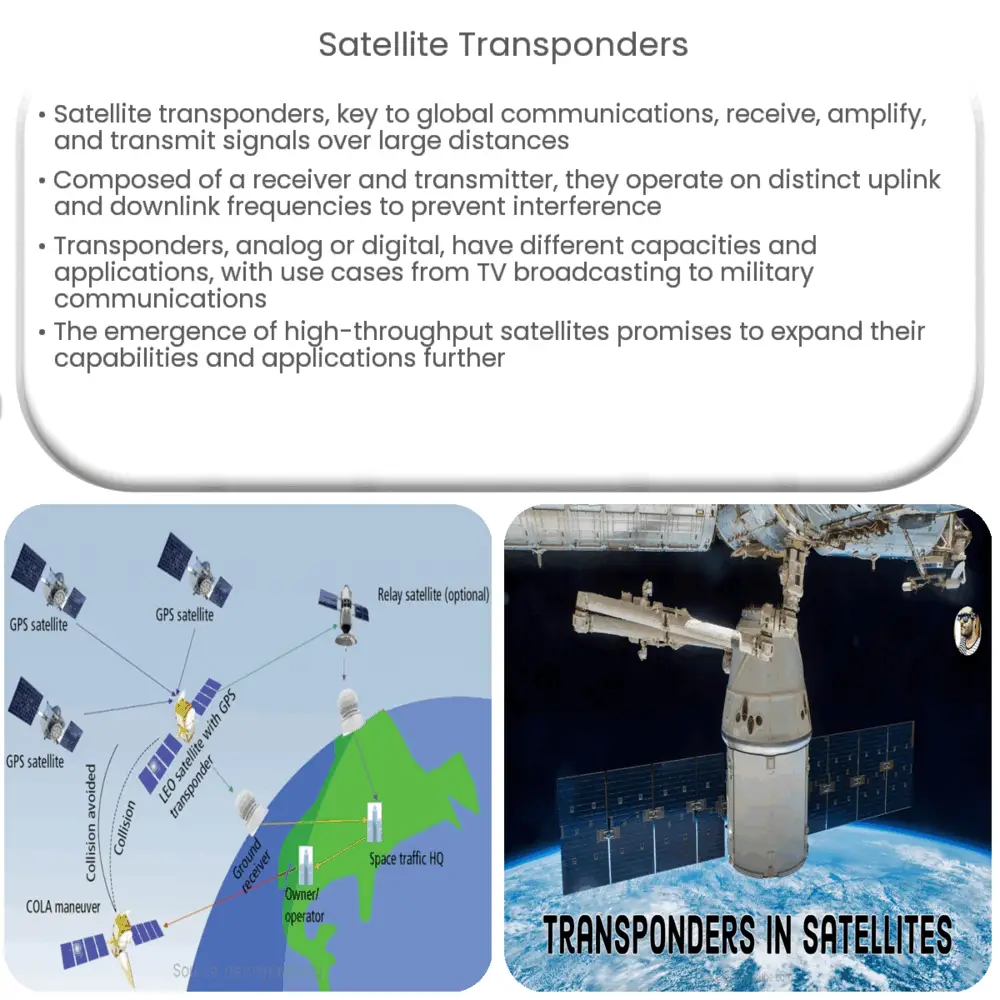Explore the role and workings of satellite transponders in telecommunications, their types, capacity, applications, and future prospects.

Understanding Satellite Transponders
A satellite transponder is a vital element of communication satellites that has garnered considerable attention in the field of telecommunications. It’s responsible for receiving, amplifying, and retransmitting signals back to Earth, allowing for the transmission of data over vast distances.
Components and Operation
A transponder consists of two key components: a receiver and a transmitter. The receiver intercepts signals from an earth station, which are then passed to the transmitter. The transmitter amplifies these signals and sends them back to the earth station. By operating on different frequencies for the uplink (from earth to satellite) and downlink (from satellite to earth), it prevents interference between the incoming and outgoing signals.
- Uplink: This is the frequency range used to send signals from the ground station to the satellite.
- Downlink: This refers to the frequency range used by the satellite to send the signal back to the ground station.
Types of Satellite Transponders
There are two primary types of satellite transponders, namely analog and digital transponders. Each has unique characteristics and applications.
- Analog Transponders: These transponders function by receiving analog signals, amplifying them, and retransmitting them back to earth. The transponder’s broad bandwidth can carry hundreds of analog TV channels or thousands of voice circuits.
- Digital Transponders: Digital transponders operate similarly but with digital signals. These signals are less susceptible to noise and can maintain high quality over long distances. They are commonly used for digital television broadcasting, data networks, and other digital communication.
A third, less common type is the bent-pipe transponder. This type is essentially a repeater in the sky, redirecting signals without modifying them. Its simplicity makes it a robust and reliable choice for certain applications.
Transponder Capacity
The capacity of a satellite transponder is measured in megahertz (MHz). One transponder generally has a bandwidth capacity of 27, 54, or 108 MHz, with larger capacity transponders capable of transmitting a greater number of channels or higher data rates.
These various characteristics and functionalities of satellite transponders highlight their crucial role in the field of satellite communications. They facilitate the broadcasting of TV channels, the functioning of global positioning systems, and the running of various data networks.
Applications of Satellite Transponders
Transponders play a pivotal role in various spheres of telecommunications, from Direct-To-Home (DTH) services and radio communication to the internet and military applications.
- Television Broadcasting: In the realm of television broadcasting, transponders help in relaying signals to DTH television receivers, playing an essential role in bringing cable and satellite television to homes worldwide.
- Radio Communication: Radio stations also utilize transponders to transmit their signals over large areas.
- Internet: Satellite internet providers leverage transponders to offer internet access in regions where traditional wired connectivity is unavailable or impractical.
- Military Applications: Transponders are instrumental in military satellite communication systems, providing secure, reliable communication for armed forces.
The Future of Satellite Transponders
The future of satellite transponders is closely tied with advancements in satellite technology. The advent of high-throughput satellites (HTS) is particularly noteworthy. HTS systems utilize a large number of smaller spot beams, which can increase the capacity and efficiency of a satellite. This is expected to revolutionize the utilization of satellite transponders, enabling higher data transfer rates and facilitating a broader array of applications.
Conclusion
In conclusion, satellite transponders have come to define modern telecommunications. They play a pivotal role in transmitting signals across the globe, facilitating an array of services from television broadcasting and radio communication to satellite internet and military communications. With the advent of new technologies like high-throughput satellites, we can expect an even greater evolution in the capabilities and applications of these devices.
The profound impact of satellite transponders on our interconnected world cannot be overstated. As we continue to push the boundaries of space and communication technology, these unsung heroes of our communication infrastructure will undoubtedly play an even more significant role in shaping our future.



